lock RENAULT TALISMAN 2016 1.G Manual PDF
[x] Cancel search | Manufacturer: RENAULT, Model Year: 2016, Model line: TALISMAN, Model: RENAULT TALISMAN 2016 1.GPages: 328, PDF Size: 3.39 MB
Page 258 of 328
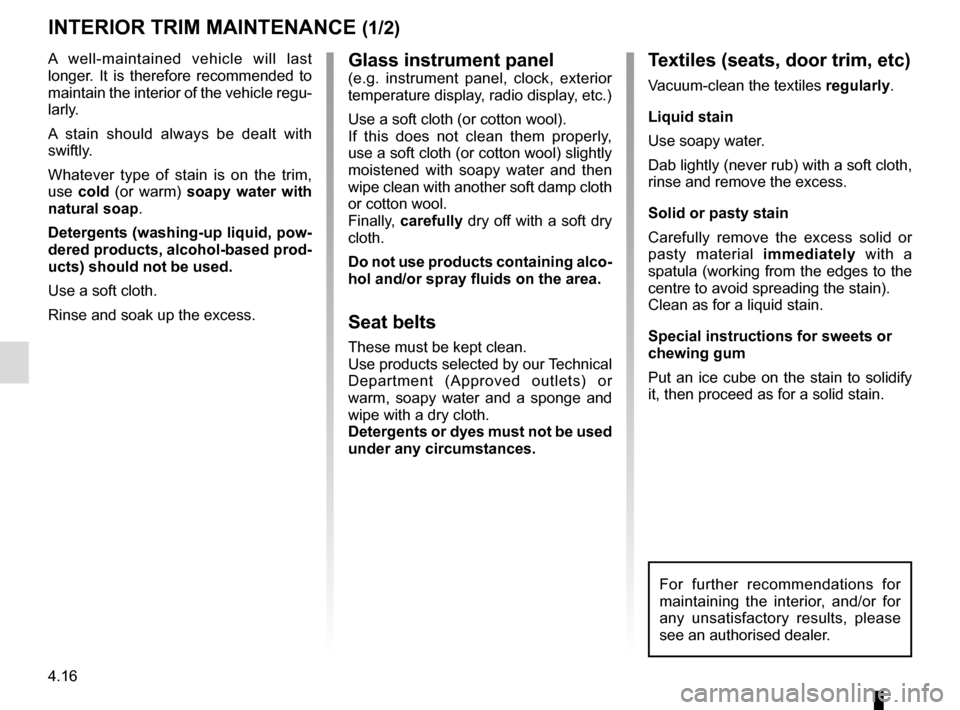
4.16
Glass instrument panel(e.g. instrument panel, clock, exterior
temperature display, radio display, etc.)
Use a soft cloth (or cotton wool).
If this does not clean them properly,
use a soft cloth (or cotton wool) slightly
moistened with soapy water and then
wipe clean with another soft damp cloth
or cotton wool.
Finally, carefully dry off with a soft dry
cloth.
Do not use products containing alco-
hol and/or spray fluids on the area.
Seat belts
These must be kept clean.
Use products selected by our Technical
Department (Approved outlets) or
warm, soapy water and a sponge and
wipe with a dry cloth.
Detergents or dyes must not be used
under any circumstances.
INTERIOR TRIM MAINTENANCE (1/2)
Textiles (seats, door trim, etc)
Vacuum-clean the textiles regularly.
Liquid stain
Use soapy water.
Dab lightly (never rub) with a soft cloth,
rinse and remove the excess.
Solid or pasty stain
Carefully remove the excess solid or
pasty material immediately with a
spatula (working from the edges to the
centre to avoid spreading the stain).
Clean as for a liquid stain.
Special instructions for sweets or
chewing gum
Put an ice cube on the stain to solidify
it, then proceed as for a solid stain.
A well-maintained vehicle will last
longer. It is therefore recommended to
maintain the interior of the vehicle regu-
larly.
A stain should always be dealt with
swiftly.
Whatever type of stain is on the trim,
use
cold (or warm) soapy water with
natural soap.
Detergents (washing-up liquid, pow-
dered products, alcohol-based prod-
ucts) should not be used.
Use a soft cloth.
Rinse and soak up the excess.
For further recommendations for
maintaining the interior, and/or for
any unsatisfactory results, please
see an authorised dealer.
Page 262 of 328
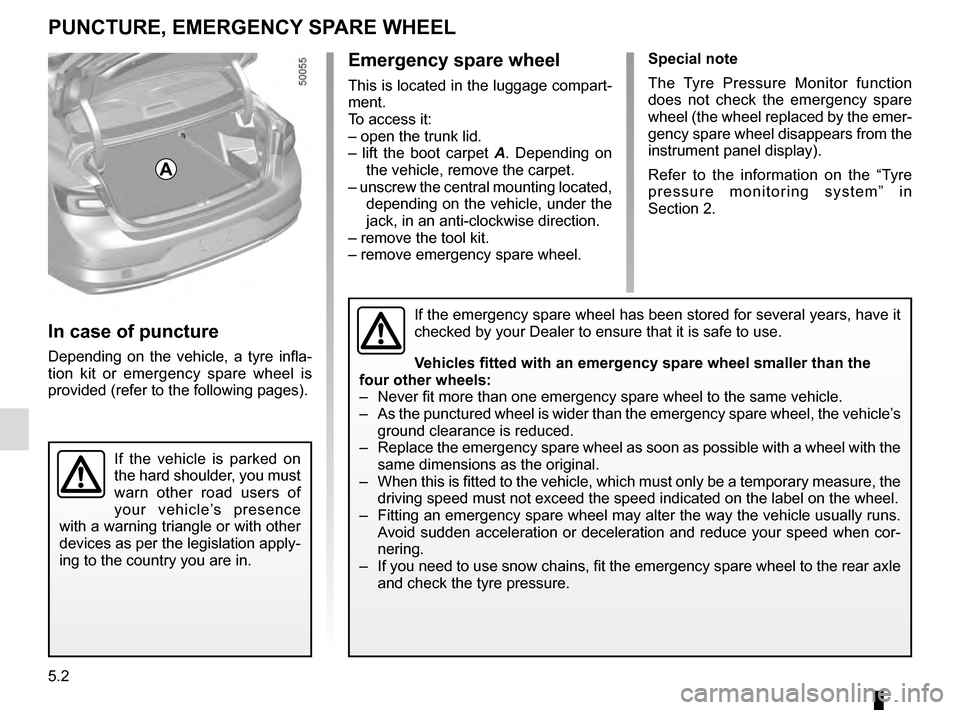
5.2
PUNCTURE, EMERGENCY SPARE WHEEL
If the vehicle is parked on
the hard shoulder, you must
warn other road users of
your vehicle’s presence
with a warning triangle or with other
devices as per the legislation apply-
ing to the country you are in.
Special note
The Tyre Pressure Monitor function
does not check the emergency spare
wheel (the wheel replaced by the emer-
gency spare wheel disappears from the
instrument panel display).
Refer to the information on the “Tyre
pressure monitoring system” in
Section 2.Emergency spare wheel
This is located in the luggage compart-
ment.
To access it:
– open the trunk lid.
– lift the boot carpet A . Depending on
the vehicle, remove the carpet.
– unscrew the central mounting located, depending on the vehicle, under the
jack, in an anti-clockwise direction.
– remove the tool kit.
– remove emergency spare wheel.
If the emergency spare wheel has been stored for several years, have it \
checked by your Dealer to ensure that it is safe to use.
Vehicles fitted with an emergency spare wheel smaller than the
four other wheels:
– Never fit more than one emergency spare wheel to the same vehicle.
– As the punctured wheel is wider than the emergency spare wheel, the vehi\
cle’s ground clearance is reduced.
– Replace the emergency spare wheel as soon as possible with a wheel with \
the same dimensions as the original.
– When this is fitted to the vehicle, which must only be a temporary measu\
re, the driving speed must not exceed the speed indicated on the label on the wh\
eel.
– Fitting an emergency spare wheel may alter the way the vehicle usually r\
uns. Avoid sudden acceleration or deceleration and reduce your speed when cor-\
nering.
– If you need to use snow chains, fit the emergency spare wheel to the rea\
r axle and check the tyre pressure.
A
In case of puncture
Depending on the vehicle, a tyre infla-
tion kit or emergency spare wheel is
provided (refer to the following pages).
Page 267 of 328
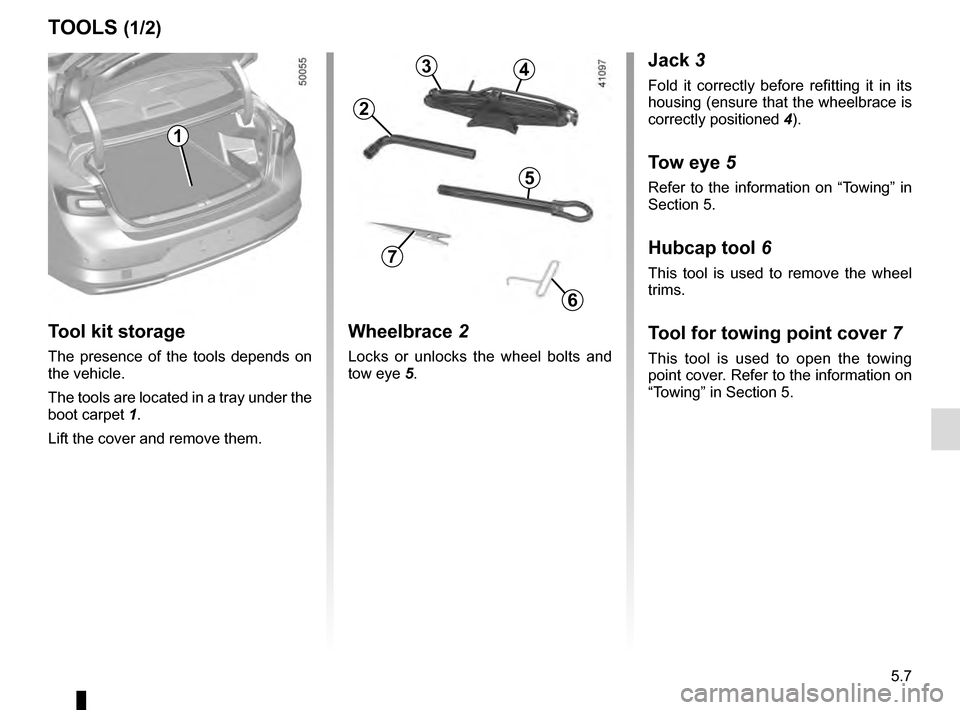
5.7
Jack 3
Fold it correctly before refitting it in its
housing (ensure that the wheelbrace is
correctly positioned 4).
Tow eye 5
Refer to the information on “Towing” in
Section 5.
Hubcap tool 6
This tool is used to remove the wheel
trims.
Tool for towing point cover 7
This tool is used to open the towing
point cover. Refer to the information on
“Towing” in Section 5.
Wheelbrace 2
Locks or unlocks the wheel bolts and
tow eye 5.
TOOLS (1/2)
3
2
5
64
B
Tool kit storage
The presence of the tools depends on
the vehicle.
The tools are located in a tray under the
boot carpet 1.
Lift the cover and remove them.
1
6
7
Page 277 of 328

5.17
Refit the bulb holder and push the light
unit in as far as it will go.
Tighten screws 4.
Check that the light unit is properly
locked in position.
5 Direction indicator lights
Bulb type: PY21.
6 Side light and brake light
Bulb type: P21W.
REAR LIGHTS AND SIDE LIGHTS: replacing the bulbs (2/5)
4-door version (cntd.)
Side lights/brake and direction
indicator lights
Open the tailgate and remove the
screws 4.
Pull on the outside A of the light and
remove the rear light unit.
Turn the bulb holder a quarter turn.
Remove the bulb. High level brake light
7
Consult an approved Dealer.
4
A65
7
Page 278 of 328
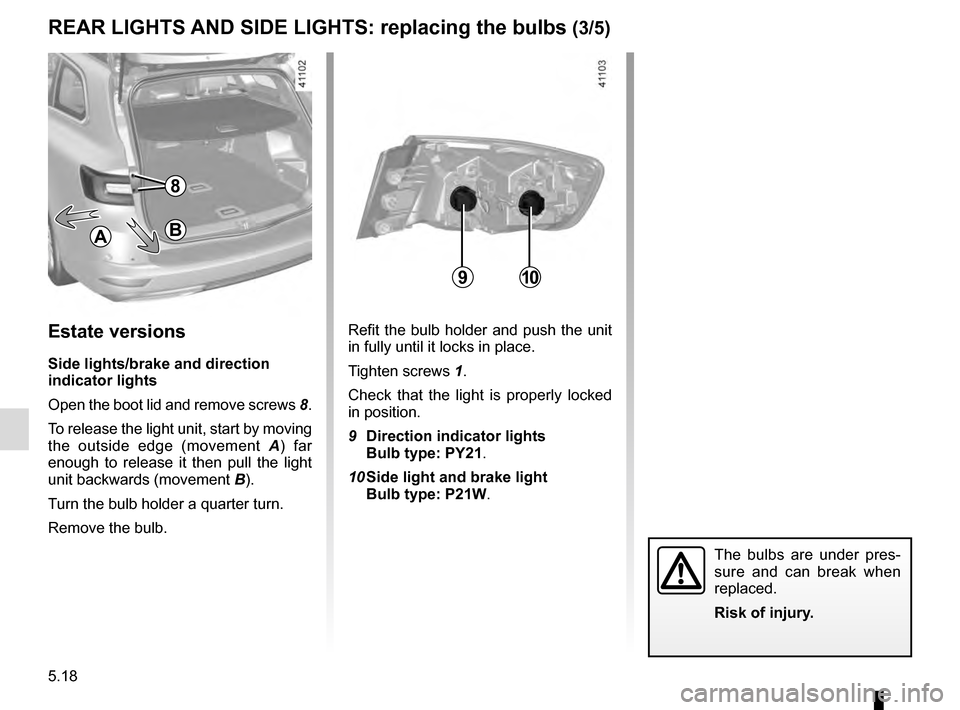
5.18
Estate versions
Side lights/brake and direction
indicator lights
Open the boot lid and remove screws 8.
To release the light unit, start by moving
the outside edge (movement A) far
enough to release it then pull the light
unit backwards (movement B).
Turn the bulb holder a quarter turn.
Remove the bulb.
Refit the bulb holder and push the unit
in fully until it locks in place.
Tighten screws 1.
Check that the light is properly locked
in position.
9 Direction indicator lights
Bulb type: PY21.
10 Side light and brake light
Bulb type: P21W.
8
REAR LIGHTS AND SIDE LIGHTS: replacing the bulbs (3/5)
910
AB
The bulbs are under pres-
sure and can break when
replaced.
Risk of injury.
Page 279 of 328
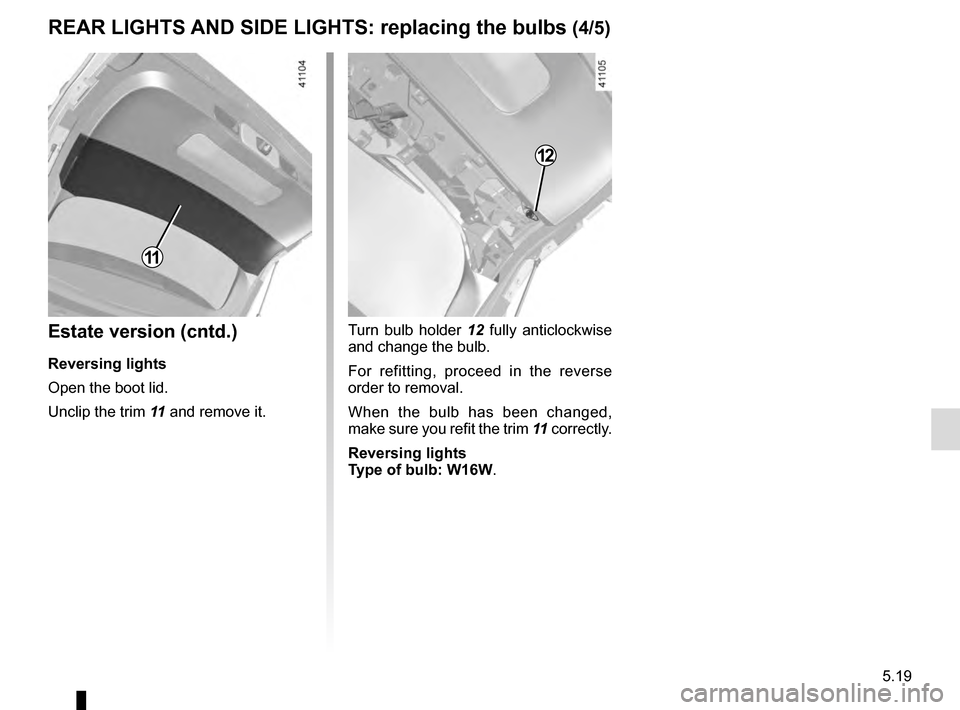
5.19
REAR LIGHTS AND SIDE LIGHTS: replacing the bulbs (4/5)
Estate version (cntd.)
Reversing lights
Open the boot lid.
Unclip the trim 11 and remove it.
Turn bulb holder 12 fully anticlockwise
and change the bulb.
For refitting, proceed in the reverse
order to removal.
When the bulb has been changed,
make sure you refit the trim 11 correctly.
Reversing lights
Type of bulb: W16W.
11
12
Page 285 of 328
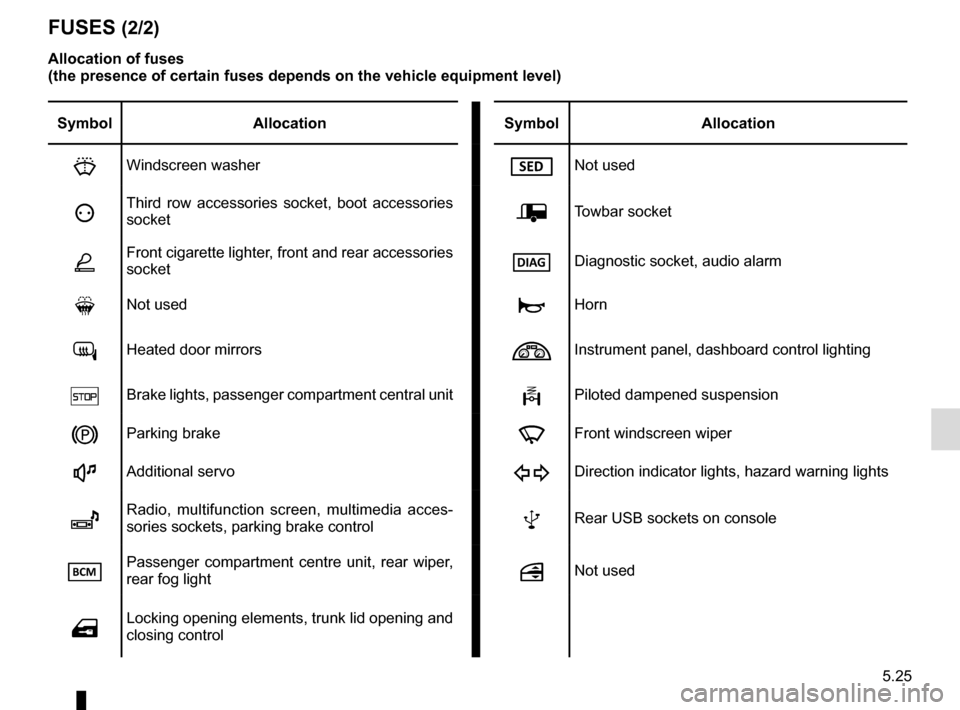
5.25
FUSES (2/2)
Allocation of fuses
(the presence of certain fuses depends on the vehicle equipment level)\
Symbol Allocation SymbolAllocation
HWindscreen washerNot used
ëThird row accessories socket, boot accessories
socketÝTowbar socket
ÆFront cigarette lighter, front and rear accessories
socketDiagnostic socket, audio alarm
Not usedÌHorn
Heated door mirrorsInstrument panel, dashboard control lighting
×Brake lights, passenger compartment central unitPiloted dampened suspension
\bParking brakefFront windscreen wiper
Additional servoDDirection indicator lights, hazard warning lights
îRadio, multifunction screen, multimedia acces-
sories sockets, parking brake controlRear USB sockets on console
Passenger compartment centre unit, rear wiper,
rear fog light\fNot used
OLocking opening elements, trunk lid opening and
closing control
Page 289 of 328
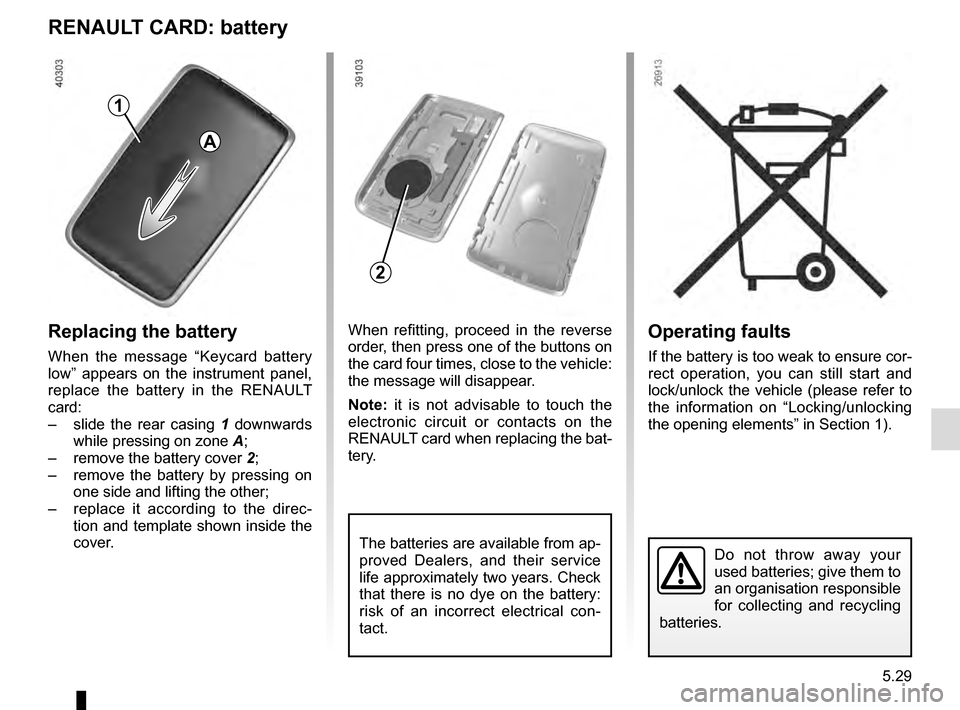
5.29
Operating faults
If the battery is too weak to ensure cor-
rect operation, you can still start and
lock/unlock the vehicle (please refer to
the information on “Locking/unlocking
the opening elements” in Section 1).
RENAULT CARD: battery
Replacing the battery
When the message “Keycard battery
low” appears on the instrument panel,
replace the battery in the RENAULT
card:
– slide the rear casing 1 downwards
while pressing on zone A;
– remove the battery cover 2;
– remove the battery by pressing on
one side and lifting the other;
– replace it according to the direc-
tion and template shown inside the
cover.
Do not throw away your
used batteries; give them to
an organisation responsible
for collecting and recycling
batteries.
When refitting, proceed in the reverse
order, then press one of the buttons on
the card four times, close to the vehicle:
the message will disappear.
Note: it is not advisable to touch the
electronic circuit or contacts on the
RENAULT card when replacing the bat-
tery.
The batteries are available from ap-
proved Dealers, and their service
life approximately two years. Check
that there is no dye on the battery:
risk of an incorrect electrical con-
tact.
2
A
1
Page 291 of 328
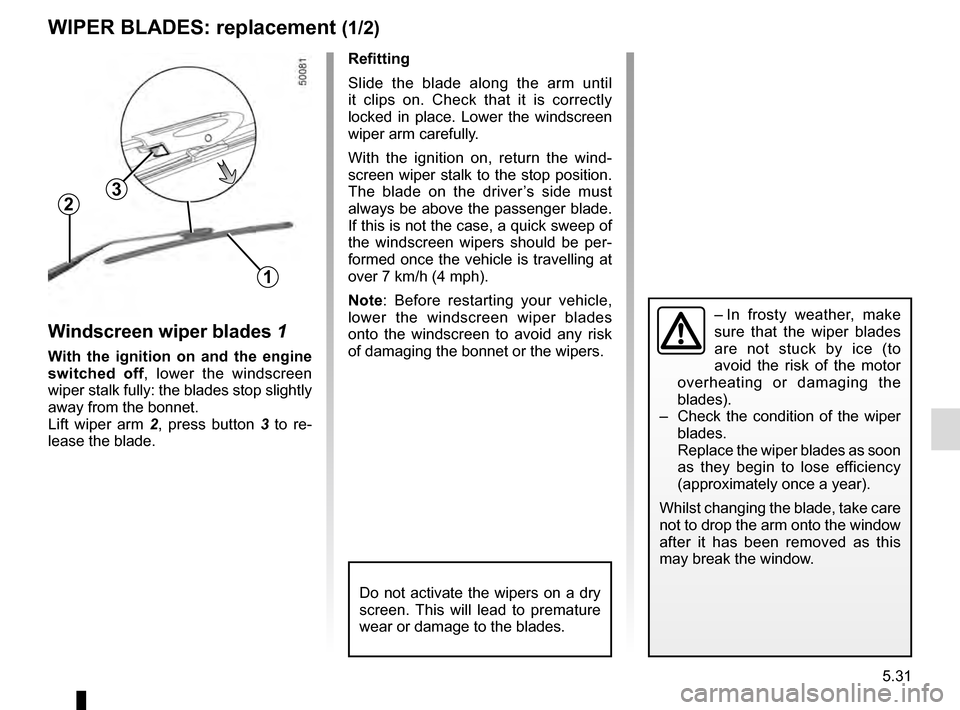
5.31
WIPER BLADES: replacement (1/2)
Windscreen wiper blades 1
With the ignition on and the engine
switched off, lower the windscreen
wiper stalk fully: the blades stop slightly
away from the bonnet.
Lift wiper arm 2 , press button 3 to re-
lease the blade.
1
32
Refitting
Slide the blade along the arm until
it clips on. Check that it is correctly
locked in place. Lower the windscreen
wiper arm carefully.
With the ignition on, return the wind-
screen wiper stalk to the stop position.
The blade on the driver’s side must
always be above the passenger blade.
If this is not the case, a quick sweep of
the windscreen wipers should be per-
formed once the vehicle is travelling at
over 7 km/h (4 mph).
Note: Before restarting your vehicle,
lower the windscreen wiper blades
onto the windscreen to avoid any risk
of damaging the bonnet or the wipers.
– In frosty weather, make
sure that the wiper blades
are not stuck by ice (to
avoid the risk of the motor
overheating or damaging the
blades).
– Check the condition of the wiper
blades.
Replace the wiper blades as soon
as they begin to lose efficiency
(approximately once a year).
Whilst changing the blade, take care
not to drop the arm onto the window
after it has been removed as this
may break the window.
Do not activate the wipers on a dry
screen. This will lead to premature
wear or damage to the blades.
Page 292 of 328
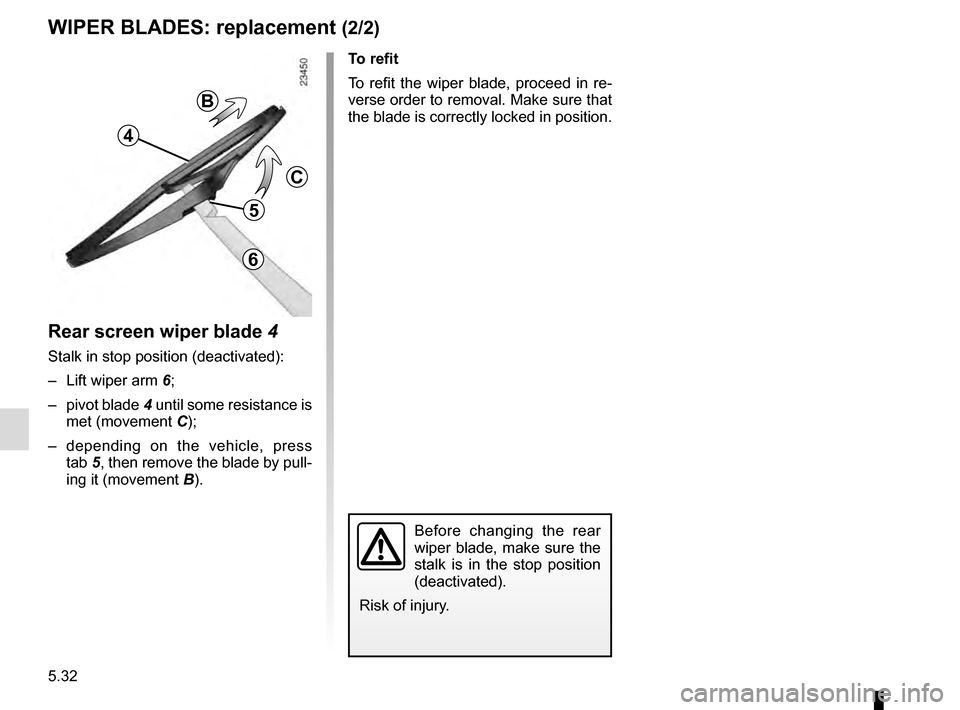
5.32
Rear screen wiper blade 4
Stalk in stop position (deactivated):
– Lift wiper arm 6;
– pivot blade 4 until some resistance is
met (movement C);
– depending on the vehicle, press tab 5, then remove the blade by pull-
ing it (movement B).
4
5
B
C
6
WIPER BLADES: replacement (2/2)
To refit
To refit the wiper blade, proceed in re-
verse order to removal. Make sure that
the blade is correctly locked in position.
Before changing the rear
wiper blade, make sure the
stalk is in the stop position
(deactivated).
Risk of injury.